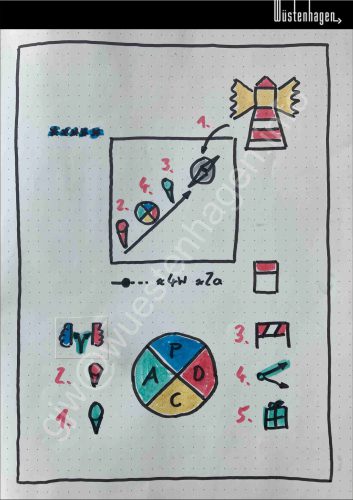KVP@GJW
DE
Verbesserungskata und Coachingkata
Warum: Eine lernende Organisation mit einer Kultur der kontinuierlichen Verbesserung schaffen und gestalten. Als Unternehmen und Mensch in einer sich schnell verändernden und komplexen Welt flexibel und lernfähig zu sein und die Unsicherheiten durch systematisches Lernen zu überwinden.
.
Wie: Durch den Einsatz eines strukturierten Verbesserungsprozesses Schritt für Schritt in Richtung eines angestrebten Zielzustands arbeiten. Dabei wissenschaftliches Denken (PDCA-Zyklus: Plan, Do, Check, Act) fördern, um Hypothesen zu formulieren und experimentell zu testen.
.
Was: Im Verbesserungskata den Rahmen für das Coachingkata schaffen:
- Aus der nahezu nicht erreichbaren Vision eine Herausforderung für die nächsten gut zwei Jahre ableiten.
- Den aktuelle Ist-Zustand beschreiben
- Den angestrebten Zielzustand der nächsten vier Wochen in Richtung der Herausforderung ableiten.
- Durch wissenschaftliches Denken (PDCA-Zyklus: Plan, Do, Check, Act) Hypothesen formulieren und experimentell testen. Gegebenenfalls durch Coachingkata begleiten.
Im Coachingkata durch die Führungskraft die Mitarbeitenden mithilfe der fünf Kata-Fragen begleiten:
- (Im C des PDCA Zyklus einsteigen) Was ist dein Zielzustand?
- Was ist dein Istzustand? (Im A des PDCA Zyklus die letzten Lernerkenntnissen fixieren)
- (Im P des PDCA-Zyklus) Welches sind die aktuellen Hindernisse auf dem Weg zum Zielzustand, welches eine Hindernis gehst du an und welche Ursache hat dieses Hindernis?
- Was ist dein nächster kleiner Schritt zum beseitige des Hindernisses und welche Wirkung erwartet du?
- Wann liegt welches Ergebnis deines Experiments vor?
Der Begriff Kata kommt aus dem Japanischen und steht für immer gleiche Übungsformen zum Beispiel im Kampfsport.
EN
Improvement Kata and Coaching Kata
Why: Create and design a learning organization with a culture of continuous improvement. As a company and as a person, to be flexible and able to learn in a rapidly changing and complex world and to overcome the uncertainties through systematic learning.
.
How: Work step by step towards a desired target state through the use of a structured improvement process. Promote scientific thinking (PDCA cycle: Plan, Do, Check, Act) in order to formulate hypotheses and test them experimentally.
.
What: Create the framework for the coaching kata in the improvement kata:
- Derive a challenge for the next two years from the almost unattainable vision.
- Describe the current status
- Derive the desired target state for the next four weeks in the direction of the challenge.
- Formulate hypotheses through scientific thinking (PDCA cycle: Plan, Do, Check, Act) and test them experimentally. If necessary, accompany with coaching kata.
In the coaching kata, the manager accompanies the employees using the five kata questions:
- (Start in C of the PDCA cycle) What is your target state?
- What is your current state? (Fix the last learnings in A of the PDCA cycle)
- (In P of the PDCA cycle) What are the current obstacles on the way to the target state, which obstacle are you tackling and what is the cause of this obstacle?
- What is your next small step to remove the obstacle and what effect do you expect?
- When will which result of your experiment be available?
The term kata comes from Japanese and stands for always the same forms of exercise, for example in martial arts.
Geplante/Erforderliche Verbesserungen
tbd
